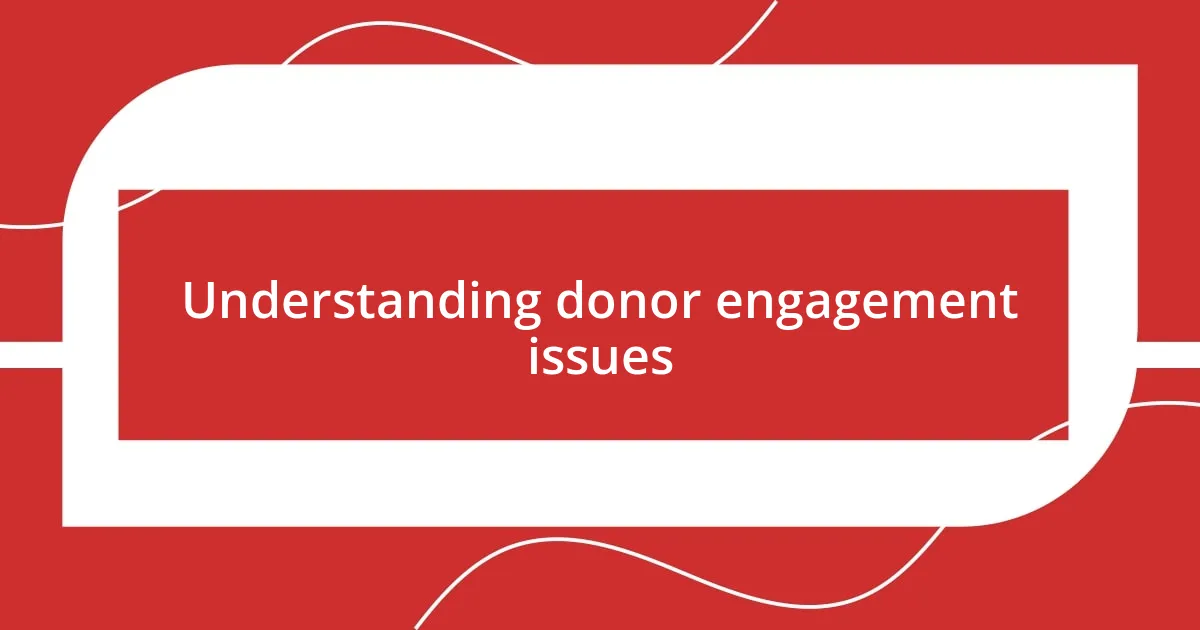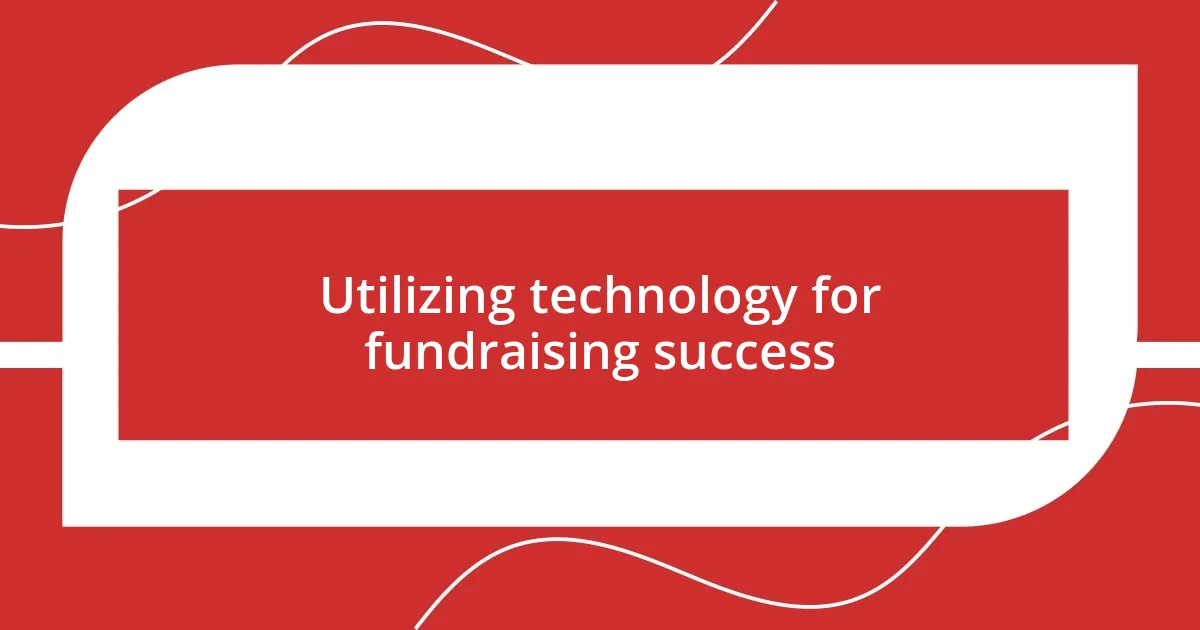Key takeaways:
- Donor fatigue and inadequate outreach are significant challenges in fundraising; maintaining fresh and engaging communication is critical.
- Personalized communication, feedback, storytelling, and follow-ups are essential for effective donor engagement.
- Utilizing technology, such as crowdfunding platforms and donor management software, can greatly enhance fundraising success.
- Successful campaigns emphasize the power of storytelling, providing updates to donors, and collaboration to innovate and engage.

Identifying common fundraising challenges
Fundraising often presents a multitude of challenges that can be frustrating for many organizations. For instance, I’ve encountered situations where even the most compelling campaigns struggled to gain traction. It makes you wonder: what’s the secret sauce that makes a campaign truly resonate with potential donors?
One downside I consistently see is donor fatigue. After a long stretch of events and appeals, supporters can feel overwhelmed and less inclined to contribute. I remember a specific gala we organized—our team had poured our hearts into it, and yet, the turnout wasn’t as high as we hoped. This experience drove home the point that it’s crucial to maintain a balance. How can we keep our messaging fresh and engaging without burning out our supporters?
Another challenge I’ve observed involves inadequate outreach and communication. If your message doesn’t reach the right audience, it’s like throwing darts blindfolded. I’ve often thought about how vital it is to understand who your audience is and what they value. Have you tried different platforms or methods to connect? Sometimes, just switching up your strategy can make a world of difference.

Understanding donor engagement issues
Understanding donor engagement issues can be quite complex. I’ve seen firsthand how a lack of personalized communication can leave donors feeling disconnected from the cause. One year, we sent out a generic email blast that lacked enthusiasm and personalization, and the response was disheartening. It reminded me that people want to feel valued and recognized. Treating donors like individuals rather than just numbers is crucial in keeping them engaged.
Here are some specific donor engagement issues to consider:
– Personalization: Sending out tailored communications that acknowledge previous support.
– Feedback: Ignoring donor feedback can alienate supporters; they want to share their thoughts.
– Storytelling: Failing to share impactful stories can make your cause seem distant and less relatable.
– Follow-ups: Not following up on donations can make supporters feel forgotten or unappreciated.
– Community: Disengaged donors often feel like they lack a connection to a community or a shared mission.
These insights have shaped my approach when working with organizations, helping them develop strategies that resonate on a deeper level with their audience.

Strategies to overcome fundraising obstacles
One effective strategy I’ve found for overcoming fundraising obstacles is to deepen donor relationships through ongoing engagement. I remember a campaign where we integrated monthly appreciation calls to our top donors. This personal touch not only made them feel valued but also invigorated their connection to our mission. The result? An increase in both donations and enthusiastic participation at events. It taught me that small gestures can have a big impact on long-term support.
Another approach involves embracing creativity in outreach. For a recent initiative, we hosted a virtual event that featured local artists, which not only raised funds but also showcased community talent. By marrying fundraising with entertainment, we created a buzz that brought in a diverse audience. I learned that innovation can breathe new life into campaigns and help combat donor fatigue by offering something fresh and appealing.
Lastly, leveraging data to tailor campaigns has been transformative. I recall analyzing past donor behaviors and discovering the types of events that drew the most interest. By focusing our efforts on similar activities, we not only increased attendance but also fostered a sense of belonging. This data-driven strategy confirmed my belief that truly understanding your audience can turn obstacles into opportunities.
| Strategy | Description |
|---|---|
| Deepening Relationships | Engage top donors through personalized communications and appreciation calls. |
| Embracing Creativity | Host unique events that blend fundraising with entertainment to attract new donors. |
| Data-Driven Targeting | Utilize data analytics to tailor campaigns and focus on appealing activities. |

Building a resilient fundraising plan
Building a resilient fundraising plan starts with flexibility. I’ve had moments where everything seemed set in stone, only for unexpected challenges to arise—like when a major donor had to pull out last minute. It felt daunting at the time, but it reminded me how crucial it is to have backup options. I suggest imagining possible scenarios and creating response strategies for each; it can make all the difference when the unexpected occurs.
Another aspect I find invaluable is community involvement. I recall a time when we engaged the local community in crafting fundraising campaigns. Not only did it foster ownership, but the collective input sparked innovative ideas. Have you ever considered how other perspectives can illuminate blind spots in your planning? Inviting diverse voices can enhance resilience by creating campaigns that resonate with a broader audience.
Lastly, ongoing evaluation is essential for refining your fundraising strategies. I remember hosting post-campaign debriefs where the team could openly discuss what worked and what didn’t. It was during these honest conversations that my colleagues revealed their most insightful ideas. Are you regularly reviewing your efforts? By analyzing performance, I believe you can adapt and strengthen your plan over time, ensuring it remains effective and relevant.

Utilizing technology for fundraising success
In my experience, technology can be a game-changer for fundraising success. I remember when we adopted a crowdfunding platform for a campaign; it was like flipping a light switch. The instant ability to share our cause through social media broadened our reach significantly, allowing us to tap into demographics we hadn’t previously engaged. Do you think your organization is fully leveraging digital platforms?
Moreover, utilizing virtual reality (VR) or augmented reality (AR) in fundraising events has impressed me. A while back, we hosted a VR experience where potential donors could virtually visit the community we were helping, immersing them in our mission. Watching their faces light up was priceless. Isn’t it incredible how technology can transform the way we connect people to our cause?
On a more practical note, integrating donor management software has streamlined our processes immensely. Before we adopted this tool, tracking donations felt like piecing together a puzzle. Now, it’s so seamless—I can easily analyze donor patterns to personalize our outreach. Have you considered how technology can make your fundraising efforts more efficient? I truly believe that embracing these advancements can lead to more successful campaigns.

Lessons learned from successful campaigns
Successful campaigns teach invaluable lessons that can shape future endeavors. One key realization for me is the power of storytelling. In a memorable campaign, we highlighted a specific beneficiary’s journey through a series of impactful stories, which ignited an emotional connection with our audience. Have you ever noticed how a compelling narrative can drive engagement? I’ve found that people are often more inspired to give when they can see the tangible impact of their contributions.
Another lesson that resonates deeply is the importance of providing updates to donors. Early in my fundraising journey, I underestimated the significance of this practice. After one campaign, I decided to send gratitude and impact reports to our supporters, sharing exactly how their money made a difference. The response was heartwarming. People love to see the fruits of their support, and this kind of connection fosters lasting relationships. Can you think of ways you might keep your donors informed and engaged?
Lastly, I learned that collaboration enhances creativity and outcomes. During a past campaign, we partnered with local artists who created unique incentives for donors. This collaboration not only diversified our fundraising approach but also built a sense of community. I often reflect on how teamwork unlocks fresh ideas that can elevate our initiatives. Have you considered reaching out to unlikely partners? The results can often exceed expectations and lead to meaningful connections.















